So maybe you want to write a song or an instrumental in a particular mood or style, and you’re feeling overwhelmed by all the scales. Here’s a handy guide to the commonly used scales in Western pop, rock, jazz, blues and so on. You can play all of these scales and more using the aQWERTYon.
Major scales
These scales have a major third (the note four that is four semitones above the root), which makes them feel happy or bright.
Major scale

Happy; can be majestic or sentimental when slow. The white keys on the piano. Examples: “Mary Had A Little Lamb,” “Twinkle Twinkle Little Star.”
Mixolydian mode
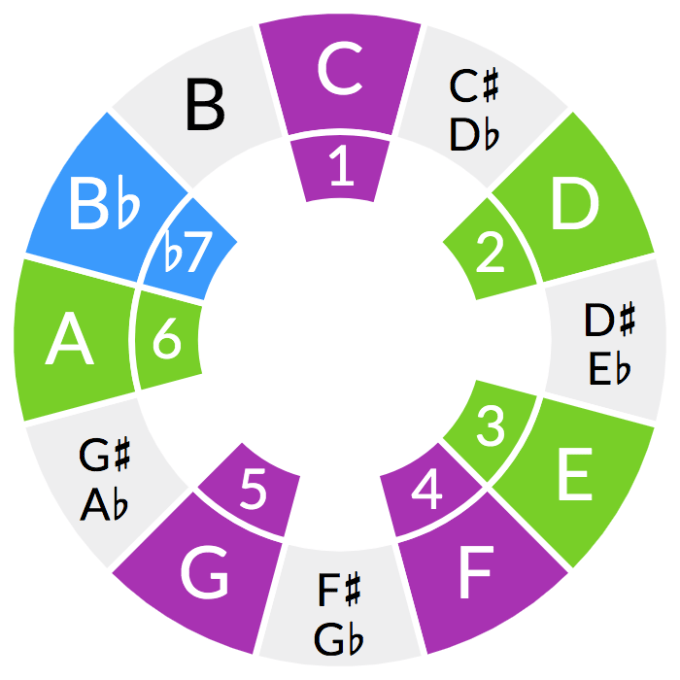
Bluesy, rock; can also be exotic/modal. Play over C7 chord. Same pitches as F major. Example: “Tomorrow Never Knows” by the Beatles.
Lydian mode
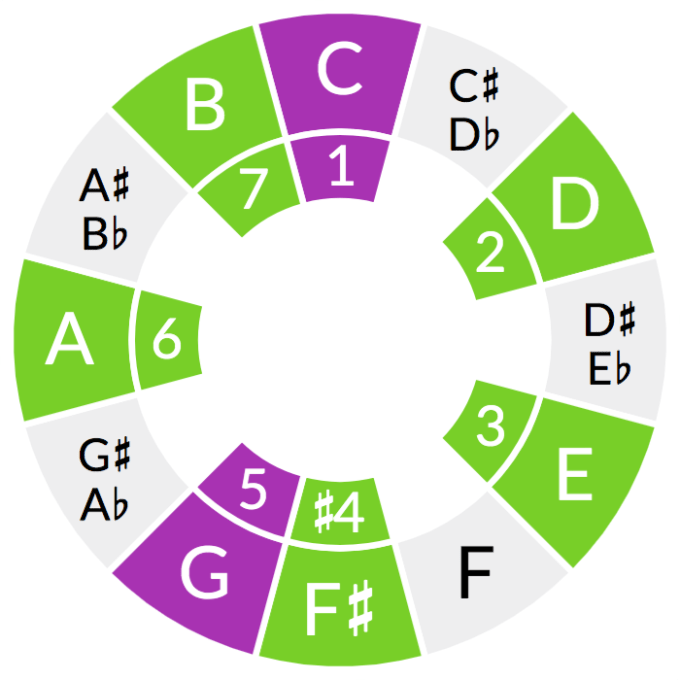
Ethereal, dreamy, futuristic. Same pitches as G major. Example: “Possibly Maybe” by Björk (from the line “As much as I definitely enjoy solitude…”)
Lydian dominant mode
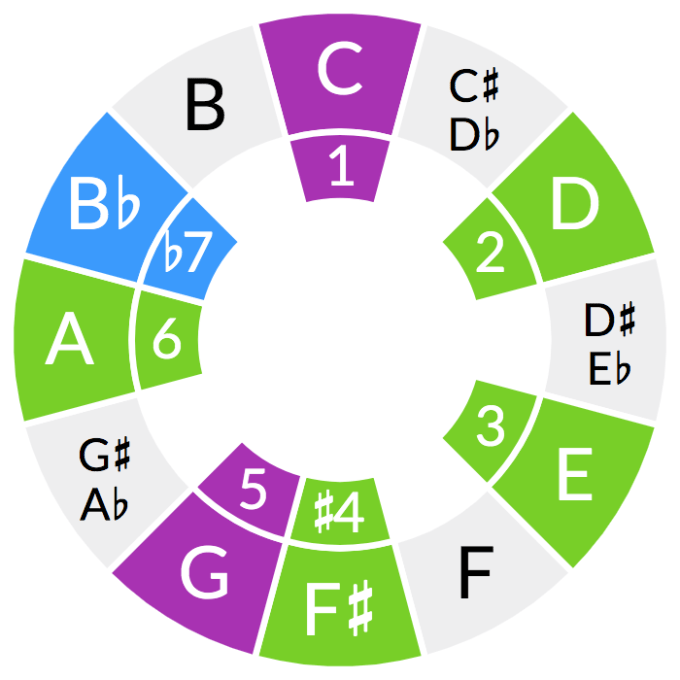
Also known as the overtone scale or acoustic scale, because it is close to the first seven pitches in the natural overtone series. Same pitches as the G melodic minor scale and the F-sharp/G-flat altered scale.
Phrygian dominant mode

Exotic, Middle Eastern, Jewish. Same pitches as F harmonic minor. Example: “Hava Nagila.”
Harmonic major scale
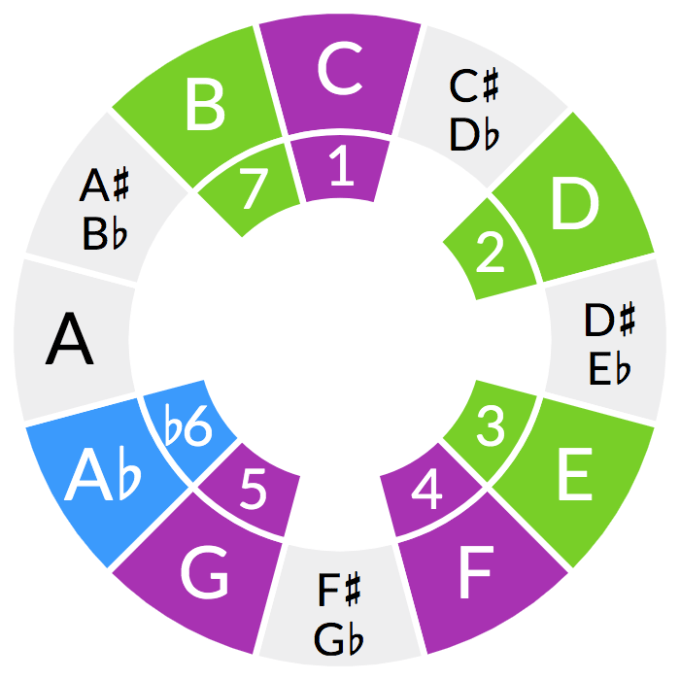
Majestic, mysterious. “Lord Of The Rings” feeling.
Mixolydian b6

Another film-score-sounding mysterious scale. Same pitches as F melodic minor.
Minor Scales
These scales have a flat third (the note that is three semitones above the root), which gives them a darker and more tragic feel.
Natural minor scale (Aeolian mode)

Sentimental, tragic. Same pitches as E-flat major.
Dorian mode

Hip, sophisticated, jazzy. Same pitches as B-flat major. Example: “So What” by Miles Davis.
Harmonic minor scale
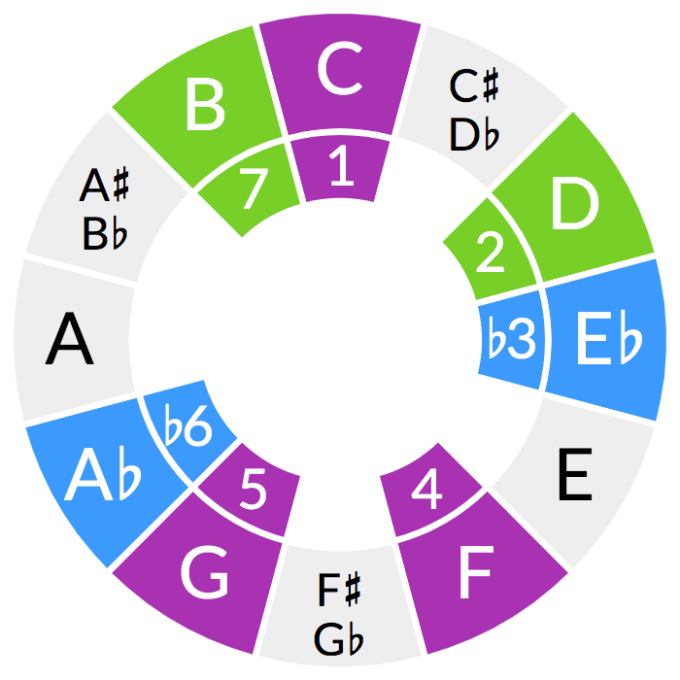
Tragic, exotic, Middle Eastern.
Melodic minor scale

Mysterious, jazzy, very dark. Example: sixties Coltrane. See a blog post about melodic minor.
Phrygian mode
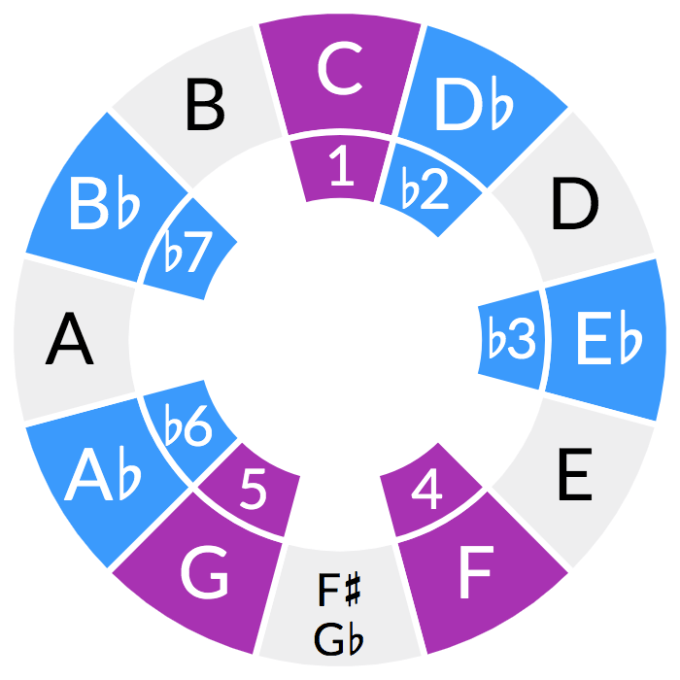
Spanish/Flamenco. Same pitches as A-flat major.
Locrian mode
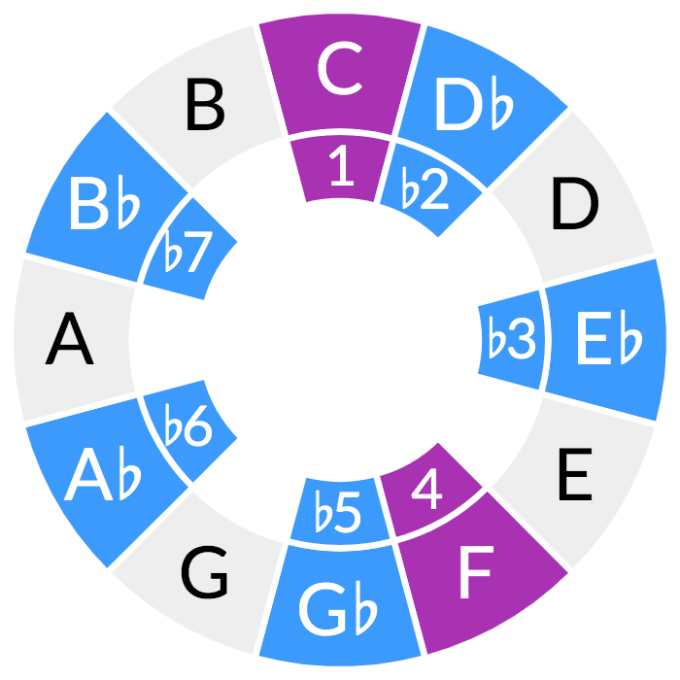
Very dark and unstable. Use over C half-diminished chords. Same pitches as C-sharp/D-flat major and B-flat natural minor.
Neither major nor minor
Blues scale
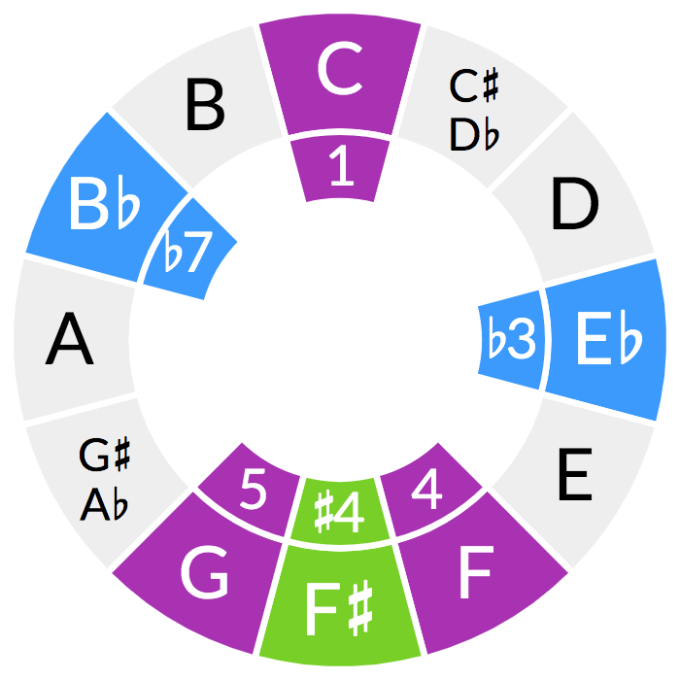
Bluesy, obviously. Works great over major and minor chords. C minor pentatonic with sharp fourth/flat fifth added.
Altered scale

Use over a C7 chord to make it sound very intellectual and jazzy. Same pitches as C-sharp/D-flat melodic minor.
Pentatonics
Pentatonic scales have five notes. The blues scale is the minor pentatonic plus the flat fifth.
Major pentatonic scale
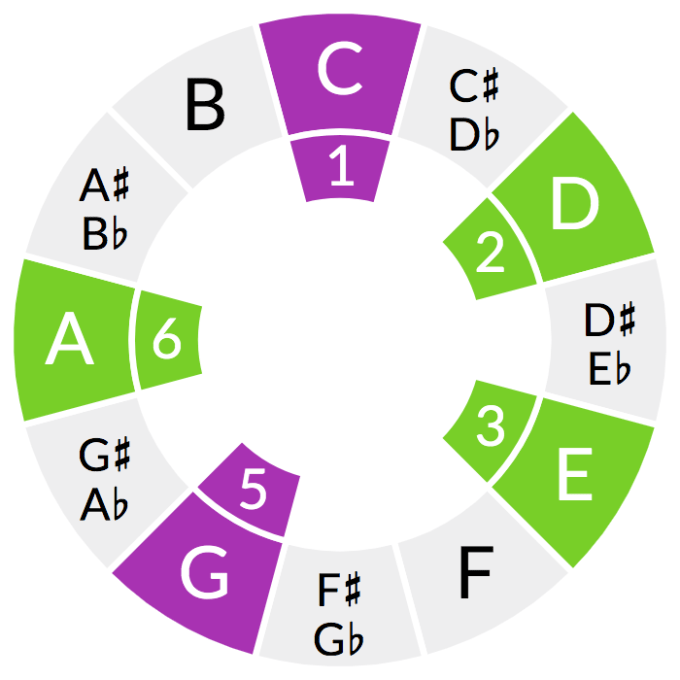
Joyful; widely used in world and folk music. Major scale with 4th and 7th removed. Same pitches as A minor pentatonic. Here’s a blog post about playing pentatonics on guitar.
Minor pentatonic scale
Widely used in rock, world and folk music. Minor scale with 2nd and 6th removed. Same pitches as E-flat major pentatonic. Here’s a blog post about playing pentatonics on guitar.
Synthetic Scales
These scales are based on regular, symmetric patterns.
Chromatic scale
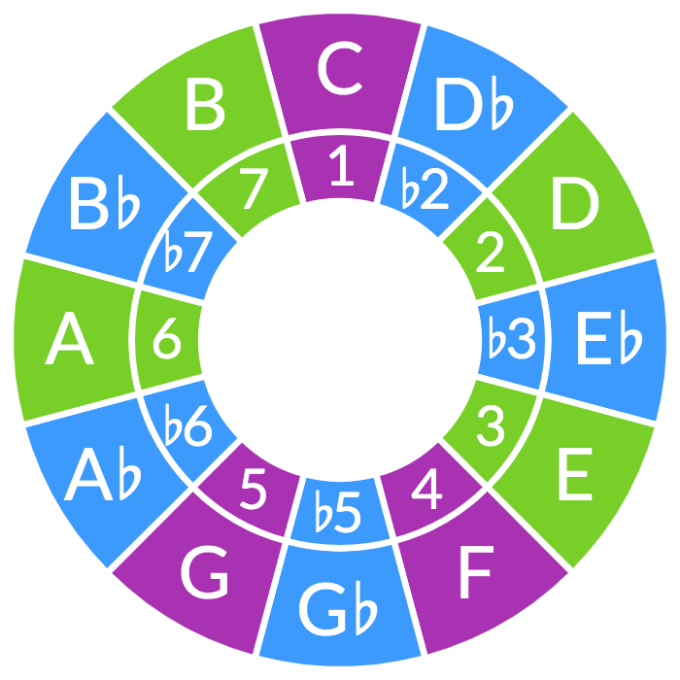
All of the piano keys. Freefalling, anxiety-producing.
Whole tone scale
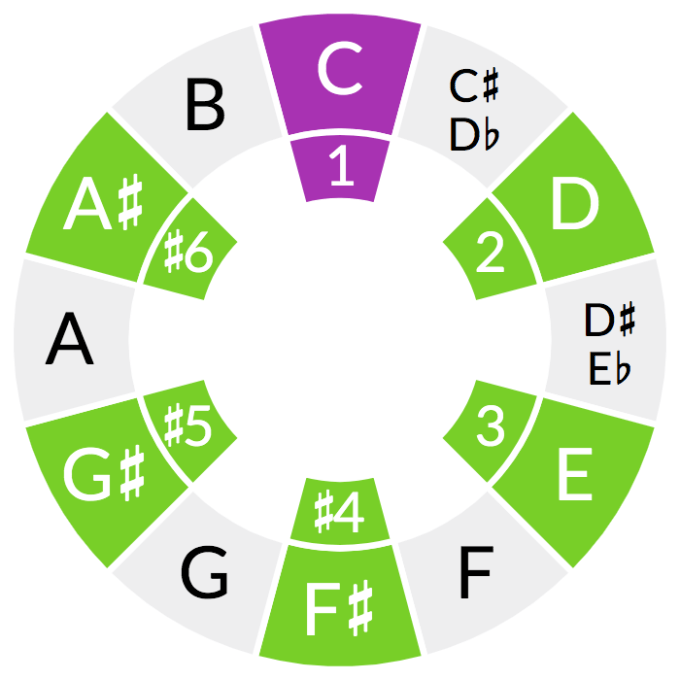
Dreamy, underwater. Every alternating key on the piano. Same pitches as D, E, F#, G# and A# whole tone scales. Example: Background parts in the Simpsons theme song.
Diminished scale

Dark, mysterious. Same pitches as Eb, Gb and A diminished scales. Examples: modern jazz, movies about Dracula.
Octatonic scale

Dark, mysterious. Same pitches as Eb, Gb and A octatonic scales. Examples: modern jazz, movies about Dracula.
Share this:
Related
The great scale flowchartJuly 7, 2021In “Music”
Inside the aQWERTYonFebruary 17, 2016In “Autobio”
Announcing the Theory aQWERTYonSeptember 9, 2019In “Autobio”This entry was posted in Composition, Emotion, Music, Music Teaching, Music Theory, Software and tagged aQWERTYon, emotion, harmony, MusEDLab, music teaching, music theory, scales, visualization. Bookmark the permalink.
Post navigation
← Inside the recording process
Glenn Gould predicts remix culture →
38 thoughts on “Scales and emotions”
 thedistractiblemrwest says:Spot on! Thank you
thedistractiblemrwest says:Spot on! Thank you- Pingback: Notaların Karakterleri – Spidervis
 Lesedi says:These are really on point and useful. Thanks
Lesedi says:These are really on point and useful. Thanks Nabil Khazzaka says:Hi Ethan,I found your blog only recently and I just wanted to thank you for addressing things that others don’t dare or like to address! I read a lot of interesting things over here! Loads of kudos to you!
Nabil Khazzaka says:Hi Ethan,I found your blog only recently and I just wanted to thank you for addressing things that others don’t dare or like to address! I read a lot of interesting things over here! Loads of kudos to you! Pedroski says:Hi Ethan,
Pedroski says:Hi Ethan,
What happened to all the pics from Flickr that are not showing anymore? Any chance this can be fixed easily, as would love to read your older articles. Ethan says:I batch-set my Flickr photos to private for various reasons, and have been slowly going through the blog manually changing the images back. I’ll fix this one immediately. Please flag any others I haven’t hit yet that you want to check out.
Ethan says:I batch-set my Flickr photos to private for various reasons, and have been slowly going through the blog manually changing the images back. I’ll fix this one immediately. Please flag any others I haven’t hit yet that you want to check out.
 zach says:I have a question what is a good mode to write hip hop in I write mostly in natural minor but if I want something not so dreery what should I do I hate the major scale every song sounds like a happy birthday type of melody
zach says:I have a question what is a good mode to write hip hop in I write mostly in natural minor but if I want something not so dreery what should I do I hate the major scale every song sounds like a happy birthday type of melody Ethan says:Yeah, major scale is pretty wack. For hip-hop, I recommend Dorian mode, it’s minor but with a jazzier and brighter feel than natural minor.
Ethan says:Yeah, major scale is pretty wack. For hip-hop, I recommend Dorian mode, it’s minor but with a jazzier and brighter feel than natural minor.
- Pingback: Modes and Moods | Time and Timeless
 Bernd Willimek says:Music and EmotionsThe most difficult problem in answering the question of how music creates emotions is likely to be the fact that assignments of musical elements and emotions can never be defined clearly. The solution of this problem is the Theory of Musical Equilibration. It says that music can’t convey any emotion at all, but merely volitional processes, the music listener identifies with. Then in the process of identifying the volitional processes are colored with emotions. The same happens when we watch an exciting film and identify with the volitional processes of our favorite figures. Here, too, just the process of identification generates emotions.An example: If you perceive a major chord, you normally identify with the will “Yes, I want to…”. If you perceive a minor chord, you identify normally with the will “I don’t want any more…”. If you play the minor chord softly, you connect the will “I don’t want any more…” with a feeling of sadness. If you play the minor chord loudly, you connect the same will with a feeling of rage. You distinguish in the same way as you would distinguish, if someone would say the words “I don’t want anymore…” the first time softly and the second time loudly.
Bernd Willimek says:Music and EmotionsThe most difficult problem in answering the question of how music creates emotions is likely to be the fact that assignments of musical elements and emotions can never be defined clearly. The solution of this problem is the Theory of Musical Equilibration. It says that music can’t convey any emotion at all, but merely volitional processes, the music listener identifies with. Then in the process of identifying the volitional processes are colored with emotions. The same happens when we watch an exciting film and identify with the volitional processes of our favorite figures. Here, too, just the process of identification generates emotions.An example: If you perceive a major chord, you normally identify with the will “Yes, I want to…”. If you perceive a minor chord, you identify normally with the will “I don’t want any more…”. If you play the minor chord softly, you connect the will “I don’t want any more…” with a feeling of sadness. If you play the minor chord loudly, you connect the same will with a feeling of rage. You distinguish in the same way as you would distinguish, if someone would say the words “I don’t want anymore…” the first time softly and the second time loudly.
Because this detour of emotions via volitional processes was not detected, also all music psychological and neurological experiments, to answer the question of the origin of the emotions in the music, failed.But how music can convey volitional processes? These volitional processes have something to do with the phenomena which early music theorists called “lead”, “leading tone” or “striving effects”. If we reverse this musical phenomena in imagination into its opposite (not the sound wants to change – but the listener identifies with a will not to change the sound) we have found the contents of will, the music listener identifies with. In practice, everything becomes a bit more complicated, so that even more sophisticated volitional processes can be represented musically.Further information is available via the free download of the e-book “Music and Emotion – Research on the Theory of Musical Equilibration:http://www.willimekmusic.de/music-and-emotions.pdfor on the online journal EUNOMIOS:http://www.eunomios.orgEnjoy readingBernd Willimek Eduardo Magalhães says:Thanks for your post! Congratulations for your work! It’s really the most inspiring and objective article I’ve read about music for years. Very scientific and the results are surprisingly precises considering issuing with emotions and musical perception. I will start composing as soon as I finish my creative protocol, but I can say that the Theory of Music Equilibration will be a fresh start for me. Thank you and Daniela so much!
Eduardo Magalhães says:Thanks for your post! Congratulations for your work! It’s really the most inspiring and objective article I’ve read about music for years. Very scientific and the results are surprisingly precises considering issuing with emotions and musical perception. I will start composing as soon as I finish my creative protocol, but I can say that the Theory of Music Equilibration will be a fresh start for me. Thank you and Daniela so much!
 Mercalus says:Yes, thank you! I’ve been looking for these! I like to play around in music making software like Cubase, and once in a while I would run into a combination of notes that just reminded me of ‘mysteriousness,’ or ‘egyptian.’ I played some of the scales above and it helps clear it up.AND I have more emotion-induced scales to play around with. This is a lifesaver–especially for the unknowledgeable music maker. =D~Merc
Mercalus says:Yes, thank you! I’ve been looking for these! I like to play around in music making software like Cubase, and once in a while I would run into a combination of notes that just reminded me of ‘mysteriousness,’ or ‘egyptian.’ I played some of the scales above and it helps clear it up.AND I have more emotion-induced scales to play around with. This is a lifesaver–especially for the unknowledgeable music maker. =D~Merc- Pingback: etudious | Pearltrees
- Pingback: teoría musical | Pearltrees
 Jeffrey Agrell says:I think it’s easier to read scales if you simply write the scale degree numbers 1-7 and add inflections. For example, Ahava raba: 1 b2 3 4 5 b6 b7, which I would also normally call the Spanish Phrygian or Klezmer – what’s in a name….?
Jeffrey Agrell says:I think it’s easier to read scales if you simply write the scale degree numbers 1-7 and add inflections. For example, Ahava raba: 1 b2 3 4 5 b6 b7, which I would also normally call the Spanish Phrygian or Klezmer – what’s in a name….?- Pingback: Francisco González C (frankeinstein) | Pearltrees
- Pingback: Getting started by sumi_gabriel – Pearltrees
- Pingback: Emily Knipe (eknipe1994) | Pearltrees
- Pingback: Pearltrees videos by bugme – Pearltrees
- Pingback: Kyle (m31music) | Pearltrees
- Pingback: Is Quora the future of blogging? « « Quora Town Quora Town
 Cschully says:i remember when I was a young organist’s apprentice my teacher was improvising for a postlude in some strange harmony; after his virtuosic composition ended I told him I liked the mode he employed, to which he replied “oh, yeah that’s a Hungarian myxoldyian scale” or some shit like that, but he said it so nonchalantly that i always remembered that. Learning music is a Socratic knowledge; the more I learn the more I learn I do not know
Cschully says:i remember when I was a young organist’s apprentice my teacher was improvising for a postlude in some strange harmony; after his virtuosic composition ended I told him I liked the mode he employed, to which he replied “oh, yeah that’s a Hungarian myxoldyian scale” or some shit like that, but he said it so nonchalantly that i always remembered that. Learning music is a Socratic knowledge; the more I learn the more I learn I do not know  Rob says:So you’re saying that the melodic minor scale sounds dark? I would have said that the major 6th especially makes it sound bright! Obviously you’ve got the minor third there to balance it out a bit, but I disagree that it’s a “dark” scale…Also, the scale you’ve called “Ahava Raba” I’ve always known as the “Phrygian Dominant” as it resembles the phrygian mode but with a major third. So I was a bit thrown by that one!Those aren’t disagreements, this is a really informative post overall!Rob.
Rob says:So you’re saying that the melodic minor scale sounds dark? I would have said that the major 6th especially makes it sound bright! Obviously you’ve got the minor third there to balance it out a bit, but I disagree that it’s a “dark” scale…Also, the scale you’ve called “Ahava Raba” I’ve always known as the “Phrygian Dominant” as it resembles the phrygian mode but with a major third. So I was a bit thrown by that one!Those aren’t disagreements, this is a really informative post overall!Rob.- Pingback: Quora
 Mangaboy01 says:thanks for all these usedul informations about pentatonical music! as for a kinda add-on to your informations, african music as well as traditionnal asiatic music are pentatonical 😉
Mangaboy01 says:thanks for all these usedul informations about pentatonical music! as for a kinda add-on to your informations, african music as well as traditionnal asiatic music are pentatonical 😉 Keith says:Octatonic is a synthetic scale!
Keith says:Octatonic is a synthetic scale! Videogamer1805 says:Locrian? Where is Locrian?
Videogamer1805 says:Locrian? Where is Locrian?- Pingback: Scales & Emotions – Future Producers forums
 Chris Bellacose says:This is great! Now I have to go listen to Dracula soundtracks!Chris
Chris Bellacose says:This is great! Now I have to go listen to Dracula soundtracks!Chris Brian Charles Clark says:This is a fantastic post for so many reasons. This whole blog is great — I love it that you’re a FB skeptic! In re music and emotion, tho, this article by a colleague of mine sheds a wee little bit of light on the subject: http://wsm.wsu.edu/s/index.php?id=843
Brian Charles Clark says:This is a fantastic post for so many reasons. This whole blog is great — I love it that you’re a FB skeptic! In re music and emotion, tho, this article by a colleague of mine sheds a wee little bit of light on the subject: http://wsm.wsu.edu/s/index.php?id=843 Ethan says:Glad you’re enjoying the blog. That article by your colleague sheds more than a wee little bit of light, there’s much food for thought there, another couple of blog posts worth at least. Thanks for writing!
Ethan says:Glad you’re enjoying the blog. That article by your colleague sheds more than a wee little bit of light, there’s much food for thought there, another couple of blog posts worth at least. Thanks for writing!
 Tiago Ribeiro says:Hi there,
Tiago Ribeiro says:Hi there,
I found your work while searching about the emotions that we associate to different scales or chords. This search is in the context of an academic research, in the field of affective computing and non-verbal communication.This is exactly what i was searching for, but it lacks references =) Could you please recommend me some literature where i can find the concepts you describe in this post? I would really love to know of a book or something that is, to music, what Goethe’s “Theory of Colors” is to color, however, i don’t know of such work. If you could help me out, I would appreciate it.Thanks!
Tiago Ribeiro Ethan says:Hi Tiago. The post lacks references because I have no idea where you’d go in the literature to find these concepts. I learned them from experience with music — all of the descriptions here are my own best attempt at describing common practice usage of the scales. If you do find any books or anything, please post a comment, and I’d love to read what you’re working on.
Ethan says:Hi Tiago. The post lacks references because I have no idea where you’d go in the literature to find these concepts. I learned them from experience with music — all of the descriptions here are my own best attempt at describing common practice usage of the scales. If you do find any books or anything, please post a comment, and I’d love to read what you’re working on.
 Ethan says:Thanks, Mr Shark.
Ethan says:Thanks, Mr Shark. Mr. Shark says:Cool little list, mate.
Mr. Shark says:Cool little list, mate. Leo says:“Don’t put fourths/elevenths into major chords unless you leave the third out” Now where’s the fun in that?
Leo says:“Don’t put fourths/elevenths into major chords unless you leave the third out” Now where’s the fun in that? Ethan says:Yeah, I know, really you should feel free to do whatever you want and I can cite a few examples where people use the third and fourth together and it sounds cool, but this is aimed at the mainstream.
Ethan says:Yeah, I know, really you should feel free to do whatever you want and I can cite a few examples where people use the third and fourth together and it sounds cool, but this is aimed at the mainstream.